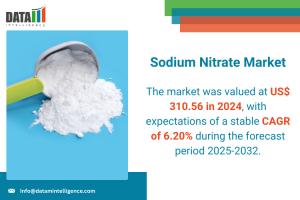Sodium Nitrate Market Set for Stable Growth Amid Rising Demand Across Industrial Sectors | DataM Intelligence
Sodium nitrate market is driven by rising demand in agriculture, food processing, and industrial sectors, with a stable CAGR of 6.20% through 2032.
Market Overview:
Demand Driven by Agriculture, Industrial Manufacturing
Sodium nitrate (NaNO₃) is an inorganic compound widely utilized for its oxidizing properties. Commonly found as a white crystalline solid, it serves as a critical raw material in fertilizers, explosives, and food preservatives. Its high solubility and stability make it a valuable input in agriculture, pyrotechnics, heat storage systems, and even pharmaceutical formulations.
The global sodium nitrate market was valued at approximately US$ 310.56 in 2024, with expectations of a stable CAGR of 6.20% during the forecast period 2025-2032.
The sodium nitrate market is experiencing steady growth driven by its diverse industrial and agricultural applications. With the rising population, rapid urbanization, and changing dietary preferences, global food demand is increasing significantly. According to the Food and Agriculture Organization (FAO), feeding a global population of 9.1 billion by 2050 will require a 70% increase in overall food production from 2005/07 levels, with nearly a 100% increase needed in developing countries. This surge in food production is driving the demand for fertilizers, where sodium nitrate plays a key role in enhancing crop yields and soil fertility.
Get Detailed Sample PDF: https://www.datamintelligence.com/download-sample/sodium-nitrate-market
The expanding industrial applications of sodium nitrate, particularly in the explosives and glass manufacturing sectors, are playing a pivotal role in driving market growth. In the explosives industry, sodium nitrate serves as a vital oxidizing agent in the production of industrial explosives used extensively in mining, construction, and defense. The ongoing global infrastructure development and the surge in mining activities, especially in emerging economies, are significantly increasing the demand for such explosives, thereby accelerating sodium nitrate consumption.
Challenges, Opportunities, Supply Chain, Regulation, and Innovation
Sodium nitrate faces significant supply chain challenges due to its reliance on mining and natural deposits, which are geographically limited and subject to geopolitical risks. Transportation and storage require careful handling because of their oxidizing properties, increasing logistical complexity and costs. Regulatory scrutiny is rising globally, as sodium nitrate is classified under hazardous materials, demanding strict compliance with safety and environmental laws. Regulatory bodies like the EPA (Environmental Protection Agency) in the US and the EU REACH framework impose strict controls on sodium nitrate’s production, storage, and usage to minimize environmental and health impacts. These regulatory pressures push companies to innovate greener alternatives and safer handling processes.
Innovations from companies such as Yara International in synthetic nitrate production reduce reliance on natural deposits, improving supply stability. Digital tools like blockchain are increasingly adopted to enhance traceability across the supply chain, reducing fraud and delays. Growing demand in agriculture, food preservation, and industrial explosives creates new market opportunities for sodium nitrate suppliers. Sustainable practices by leaders like CF Industries allow them to meet regulations while boosting brand reputation.
Asia-Pacific Leads Driven by Rapid Industrialization and Agricultural Expansion
Rising demand for sodium nitrate as a key component in fertilizers to enhance crop yields is a primary driver, supported by the region's large agricultural base. Government initiatives promoting agricultural productivity and infrastructure development further stimulate market growth. For instance, the Government of India has substantially boosted its agricultural budget from US$ 1390.71 million (₹11,915.22 crore) in 2008-09 to US$ 1,430.122 billion (₹1,22,528.77 crore) in 2024-25, reflecting a strong commitment to the sector. This enhanced funding supports greater fertilizer subsidies and adoption, including sodium nitrate-based fertilizers, which are vital for improving soil nutrient levels and crop yields. Increased investment in agriculture infrastructure and productivity encourages higher usage of sodium nitrate as a key input, boosting demand.
Additionally, the booming manufacturing industries in countries like China, India, and Japan fuel the demand for sodium nitrate in explosives, glass production, and food preservation applications. China leads the Asia-Pacific sodium nitrate market, followed by Japan and South Korea, with India demonstrating strong growth potential. Additionally, ASEAN countries—especially Malaysia, Thailand, and Indonesia—are experiencing significant investments in construction glass and infrastructure development, further driving regional demand for sodium nitrate. The rapid urbanization and infrastructure development across the region have spurred construction activities, further propelling the demand for high-quality glass products used in windows, automotive, electronics, and packaging industries. This industrial growth directly correlates with increased sodium nitrate consumption, as manufacturers rely on it to optimize production processes.
Key Market Players:
Major market participants include BASF SE, Sumitomo Chemical Co., Ltd., Merck KGaA, SQM (Sociedad Química y Minera de Chile), and Shandong Haihua Group. These companies are investing in production capacity expansions, mergers, and R&D to develop high-purity sodium nitrate variants.
For detailed insights, market segmentation, and competitive benchmarking, access the full Sodium Nitrate Market report here: https://www.datamintelligence.com/buy-now-page?report=sodium-nitrate-market
Related Reports:
Sodium Chlorite Market Size 2024-2031
Sodium Cyanide Market Size 2024-2031
Sai Kiran
DataM Intelligence 4market Research LLP
+1 877-441-4866
sai.k@datamintelligence.com
Visit us on social media:
LinkedIn
X
Legal Disclaimer:
EIN Presswire provides this news content "as is" without warranty of any kind. We do not accept any responsibility or liability for the accuracy, content, images, videos, licenses, completeness, legality, or reliability of the information contained in this article. If you have any complaints or copyright issues related to this article, kindly contact the author above.
Freen anunță lansarea turbinei eoliene de 20 kW pentru ferme și industrie
Vampa Tire Supplies Introduces Tire Hammer Bead Breaker and Bead Bazooka
Freen wprowadza turbinę wiatrową 20 kW dla prosumentów
Kalendarium
Więcej ważnych informacji
 Jedynka Newserii
Jedynka Newserii

 Jedynka Newserii
Jedynka Newserii

Handel

Komisja Europejska chce wprowadzić ujednolicone przepisy dotyczące wyrobów tytoniowych. Europosłowie mówią o kolejnej nadregulacji
Ministerstwo Zdrowia opracowało nowy projekt przepisów wprowadzających kolejne zakazy dotyczące wyrobów tytoniowych – całkowitą eliminację e-papierosów oraz zakaz aromatów w woreczkach nikotynowych. Najprawdopodobniej w ciągu kolejnych dwóch–trzech lat Polska będzie musiała implementować nową dyrektywę dotyczącą wszystkich produktów tytoniowych, nad którym niebawem ma rozpocząć prace Komisja Europejska. Europosłowie mówią o ryzyku chaosu legislacyjnego, nadregulacji i wskazują na zagrożenia związane z proponowaną podwyżką akcyzy.
Konsument
Za trzy miesiące ruszy w Polsce system kaucyjny. Wątpliwości budzą kwestie rozliczeń i podatków

Zaledwie trzy miesiące zostały do startu systemu kaucyjnego w Polsce. Kaucje obejmą szklane i plastikowe butelki oraz puszki z napojami. To duża zmiana dla producentów napojów, sklepów i konsumentów oraz pośredniczących w zbiórce operatorów systemów kaucyjnego. Na razie przepisy są na tyle niedoprecyzowane, że budzą wiele wątpliwości w kwestii rozliczania podatków czy rozliczeń z operatorami. Producenci będą musieli płacić podatek od niezwróconych butelek, co zwiększy ich koszty.
Transport
Rośnie skala agresji na polskich drogach. Problemem jest nie tylko nadmierna prędkość, ale też jazda na zderzaku

Za kilka dni zaczynają się wakacje, czyli statystycznie najniebezpieczniejszy czas na drogach. Wśród głównych przyczyn takich zdarzeń na prostych odcinkach drogi są nadmierna prędkość i jazda na zderzaku. Zarządca autostrady A4 Katowice–Kraków w ramach kampanii „Nie zderzakuj. Posłuchaj. Jedź bezpiecznie” zwraca uwagę na zjawisko agresji na polskich drogach i przypomina, że bezpieczeństwo zaczyna się od osobistych decyzji kierowcy.
Partner serwisu
Szkolenia

Akademia Newserii
Akademia Newserii to projekt, w ramach którego najlepsi polscy dziennikarze biznesowi, giełdowi oraz lifestylowi, a także szkoleniowcy z wieloletnim doświadczeniem dzielą się swoją wiedzą nt. pracy z mediami.










.gif)

 |
| |
| |
|